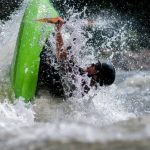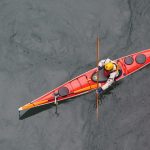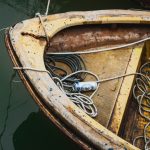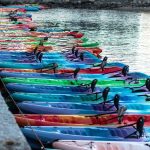When a kayak capsizes, you need to act quickly and safely. Check our tips on how to rescue kayaks and keep yourself and other paddlers safe on the water.
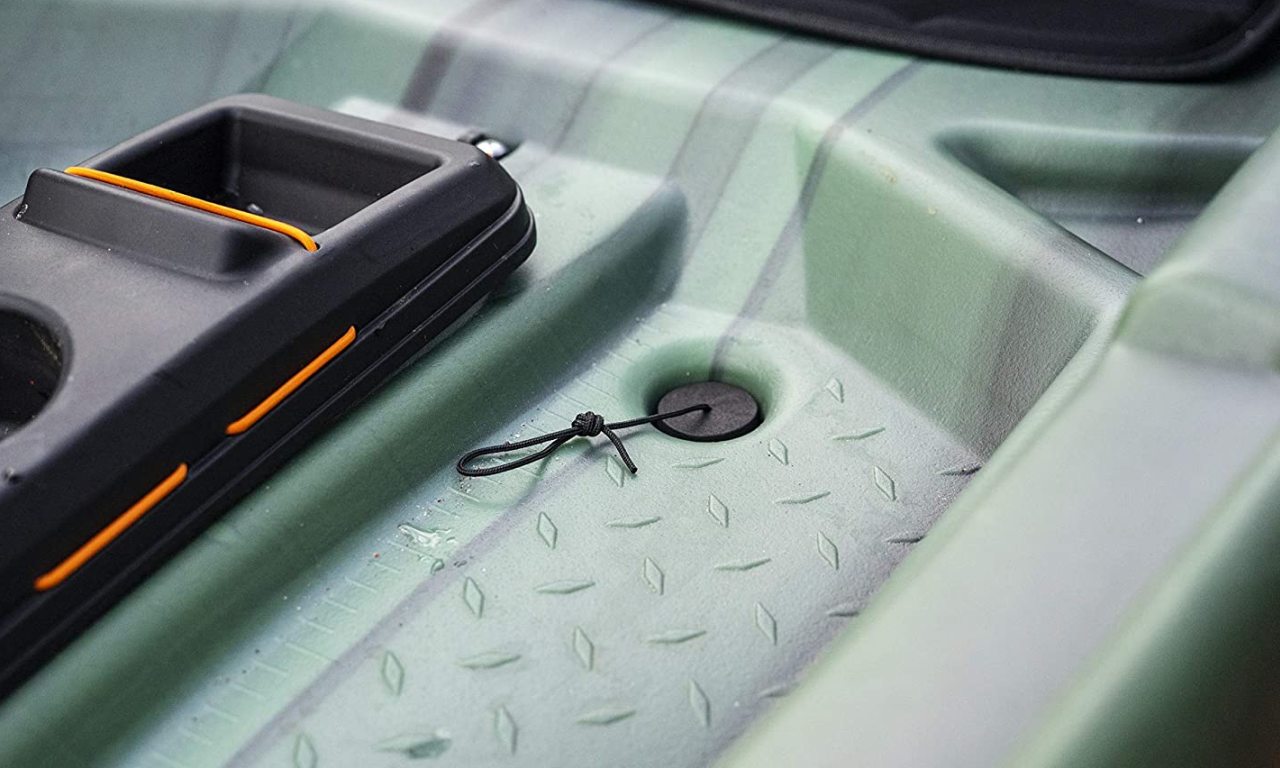
Scupper plugs are likely one of those kayak accessories you’ve never heard about, but boy are they an important piece of equipment!
Turns out that without scupper plugs, you’re going to have a much harder, wetter time kayaking.
In this article, we’ll take a deep dive into this small-but-essential piece of kayaking gear, looking at what scupper plugs are, what they do, and how to use them.
We’ll even include a few solutions for DIYing your own scupper plugs and the best scupper plug replacements on the market.
Get ready to learn everything there is to know about these useful, practical kayak plugs!
What are Scupper Plugs?
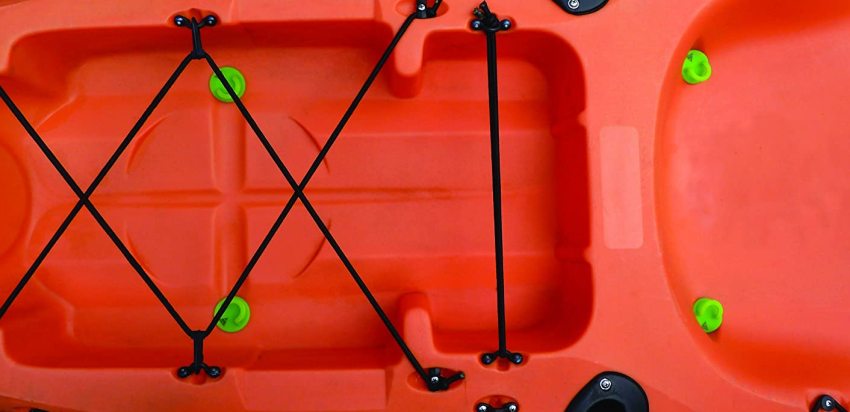
The term “scupper” is actually an old one; around 500 years old, to be precise. It’s used to refer to the drain holes built into the sides of the ship. These holes were included to allow not only water to drain from the deck, but to also allow blood to be washed off the deck after a battle.
Scupper plugs are exactly what they sound like: plugs that block up the scupper holes. They’re typically made from rubber or soft plastic, and are designed to be inserted into scupper holes in order to block water from getting through the holes.
What Do Scupper Plugs Do?
As you know, there are two types of kayaks: sit-inside and sit-on-top kayaks.
With sit-inside kayaks, you want to keep the cockpit as water-tight as possible, because it is submerged far beneath the water line. Any water seeping into the cockpit will weigh down the kayak and make it more difficult to paddle, ultimately contributing to a higher risk of capsizing.
With sit-on-top kayaks, however, you’re sitting on top of the kayak, which is in turn sitting on top of the water (largely). This means that any water that accumulates on the open deck can be drained out via the scupper holes integrated into the base/hull of the kayak.
If you are paddling on calm waters, you’ll likely want to keep the scupper holes open and unplugged so any water that splashes up onto the deck of your kayak can drain away. However, when the water is choppy, water is more likely to splash up through the scupper holes, so this is when you want to insert the plugs. That way, you’ll stay as dry as possible. Though the water won’t be able to drain out as easily, there’s less risk of water splashing up from inside the kayak and getting you wet.
This is ideal for cold-weather kayaking, too. There will be some water splashing over the sides (it’s the drawback of sit-on-top kayaks), but if you’re paddling on calm waters, you can usually stay largely dry. By plugging up the scupper holes, you keep the chilly water from splashing up and onto the deck of your kayak.
Inserting the scupper plugs also creates a seal that ensures the kayak floats higher on the water. This means greater buoyancy, which in turn allows you to carry a heavier load (i.e. a heavier kayaker/passenger and/or more gear). You’ll also paddle faster when you sit higher on the water, covering more distance more efficiently.
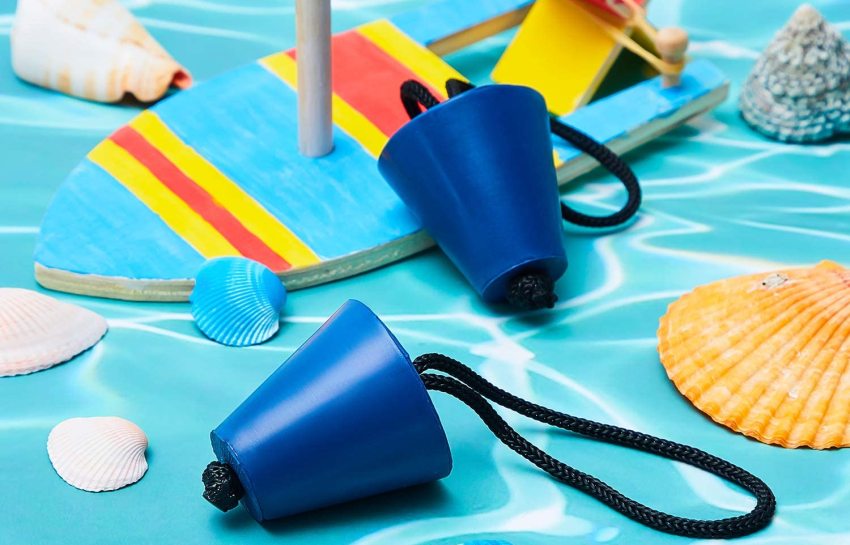
Disadvantages of Scupper Plugs
I want to be clear: scupper plugs, as useful as they are, do have some minor drawbacks.
Because they’re closing up the scupper holes, scupper plugs stop water from draining out of the kayak. This means that any water splashing over the sides will stay on the deck. Eventually, it could accumulate to the point that it will make paddling more difficult, and may even contribute to a higher risk of capsizing.
Speaking of capsizing, one of the great things about scupper holes is that they make it easy for you to right and drain your sit-on-top kayak in case of capsize. However, when you’ve got the scupper plugs in, the water won’t be able to drain out, so you’ll have to bail out the kayak by hand.
One of the upsides I mentioned above (your kayak riding higher on the water due to greater buoyancy) can actually be a downside in certain situations. On a calm, clear day with little wind, it’s great to ride high on the water because of how fast you can go.
But if there’s a lot of wind, the wind will actually push you around when you ride higher on the water. It’s actually better to be riding low in the water on windy days, because there will be less surface area for the wind to push against, and thus less risk of the wind blowing you off-course and making handling a challenge.
The good news is that these “downsides” aren’t really a permanent problem. All you really have to do to allow water to drain out is to pull the scupper plug—they’ve got a loop integrated into their design to make them easy to pull out. You’ll have no trouble draining out your water-logged kayak, and riding lower in the water will make it easier to paddle in high-wind conditions.
Do Sit-Inside Kayaks Need Scupper Plugs?
As I mentioned above, sit-inside kayaks are built with a hull that keeps water from getting in. The cockpit actually largely encloses the paddler, and you can add on a spray skirt that prevents water from splashing over the sides of the kayaks and seeping into the cockpit.
With a spray skirt, the cockpit is as “waterproofed” as possible—meaning some water will get in, but enough that it requires constant draining.
Because of this, there is really no need to install scupper holes on the bottom of a sit-inside kayak. You can use a hand pump to bail out water, but for the most part, a sit-inside kayak with a secured spray skirt will remain dry enough that any water that seeps in won’t be enough to cause any real issues.
You can simply overturn the kayak when you return to land and drain out any water by pulling the two scupper plugs integrated into the upper side of the hull (usually one for the cockpit, and another for the compartment/s).
Will My Kayak Sink Without Scupper Plugs?
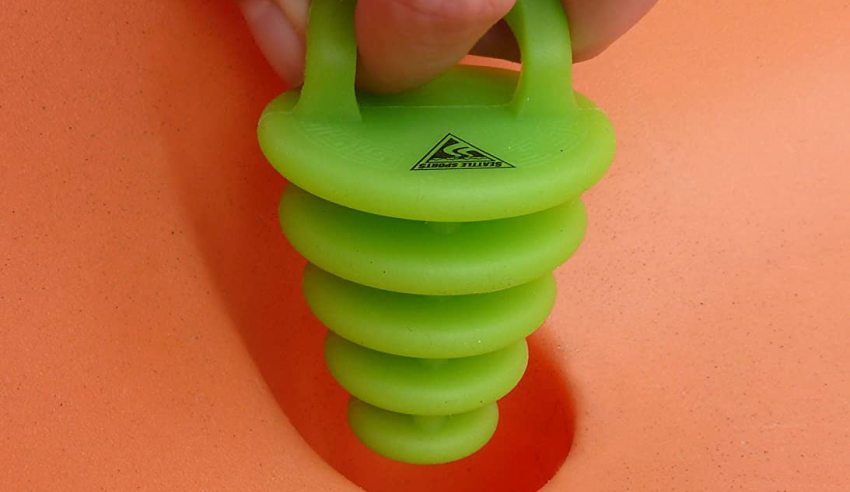
No, it will not!
Scupper plugs are designed to stop up the scupper holes, which are integrated into the hull of your sit-on-top kayak so water can drain out. The holes will allow some water to splash in, but it will drain right back out again. If you’ve got the plugs pulled and the scupper holes open, your kayak will always be self-draining, so though it may get wet, you’ll never end up sitting in a puddle of water or taking on so much water that the kayak sinks.
And, thanks to the scupper holes, it’s much easier to right a capsized kayak. Once the kayak is flipped back over onto the right side, the water will drain out through the holes, leaving you with a (mostly) dry deck.
How Can I Drain Water from My Kayak Without Pulling the Scupper Plugs?
If you’re taking on a bit of water but you don’t want to pull the scupper plugs, there are a couple of options you can use to keep your kayak dry:
1) Bilge pump. This is a pump (either hand-powered or motorized) that sucks up water from your kayak and sprays it overboard. Bilge pumps tend to be compact, easily used devices that are small enough to keep in with your kayak emergency kit or on-board gear. Keep it handy, and it will make it easy to pump all the excess water off the deck of your kayak.
2) Kayak sponge. Kayak sponges—like the Perception Kayak Sponge—are exactly what they sound like: large sponges that you can keep on the deck of your kayak to soak up water. Typically, they’ll absorb around 1-2 liters of water before needing to be wrung out. They’re a great solution to keep your deck largely dry on calm days when you don’t expect a lot of water to splash over the sides of your kayak.
Both of these solutions will allow you to keep the scupper plugs firmly in place so you ride high in the water, but still maintain a dry deck.
How to Use Scupper Plugs
Scupper plugs are designed with a cylindrical shape, but with one side that is slightly narrower than the other. This is the side that is inserted into the scupper hole.
To use the scupper plug, simply insert the narrow side into the scupper hole, and push until it won’t go any deeper into the hole. Typically, the soft plastic or rubber will push far enough into the hole to create a properly air-tight plug that won’t allow any water to seep through.
When you’re paddling, if you ever want to pull the scupper plug, there is usually a rope or cord loop secured to the plug’s rear-side. You can simply hook a finger (or two) through the loop and give it a good tug to pull the plug free. Once the water is drained, re-insert the plug and push hard until it’s once more creating a water-tight seal.
How Many Scupper Plugs Does a Kayak Need?
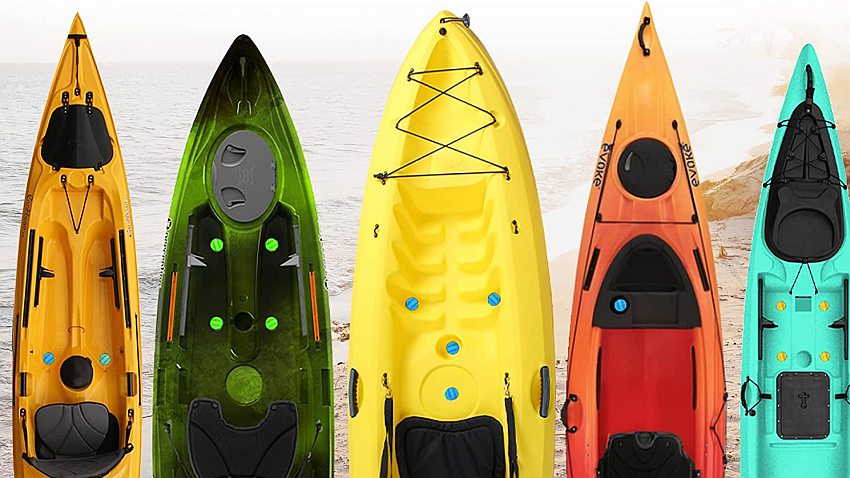
The average sit-inside kayak will usually have 2-3 scupper holes integrated into the upper side of the hull—one for the cockpit, and one for each water-tight compartment.
Sit-on-top kayaks, on the other hand, will usually have more—as few as 4 or as many as 8. These are distributed all along the length of the hull to allow water to drain evenly from the cockpit area and all the gear storage compartments.
You don’t have to paddle with all the plugs in the scupper holes. For example, if you want to allow at least a little water to drain out, you can paddle with two of the scupper plugs pulled, and the rest securely inserted to stop water from splashing up from beneath. You can keep the plugs beneath the cockpit in place and only remove the plugs from the gear compartments, or vice versa.
You’ll want to have enough plugs to stop up all the scupper holes, but just because you have them, that doesn’t mean they always have to be secured. You can insert or remove them as desired, according to what works best to keep your kayak dry and drained of water.
Testing Scupper Plugs
If you’re buying a new (or new-to-you) kayak or have just procured a new set of scupper plugs, it’s always worth testing the plugs to see how well they work. You want to make sure that A) they will provide the water-tight plug, but also B) can be easily pulled and re-inserted for maximum convenience.
To test the scupper plugs:
Step 1: Set your kayak up on a stand. Use a kayak stand to elevate your kayak off the ground and give you a clear view of the underside (hull). That way, if there are even tiny drips, you’ll be able to see them in an instant.
Step 2: Insert the plugs into a dry kayak. “Dry” is important, because you want to make sure there is no seepage and no drips from existing water. Make sure the kayak is free of water before inserting the plugs into the scupper holes. Push hard enough that you feel the seal is properly watertight, but can still pull the plug without excessive effort.
Step 3: Pour water into the scupper holes. Grab a 1-gallon milk jug and fill it with water. Pour that water into each of the scupper holes, filling the drains completely. Now, look underneath the kayak to see if there is any water draining from the scupper plugs. If the water is dripping out, try pushing the plugs in more firmly. If that doesn’t work, it’s possible the plugs are defective, or the hole itself has a leak.
Step 4: Pull the plugs to drain the water. Once you’ve got a watertight seal that doesn’t leak, pull the plugs one by one to make sure they can be easily removed. Allow the water to fully drain, then re-insert the plugs and re-fill the holes with water. This will be a test to determine how easy it is to re-insert the plugs as well as how water-tight the plugs are after draining out water.
Step 5: Test it on the water. Before you head out for your next paddling trip, take a few minutes to repeat this test. Insert the plugs and check for any leakage or seepage. Then pull the plugs to let the water drain out, and re-insert them to make sure they’re properly watertight.
It’s always worth testing out your scupper plugs before heading out into open water. It’s not common, but it does happen that the rubber or plastic is defective, damaged, or flawed, and it doesn’t quite create the proper seal. A few minutes of testing beforehand will allow you to contact the manufacturer and get a replacement for faulty or damaged plugs, or give you peace of mind that your scupper plugs are in good shape!
DIY Scupper Plugs
Did you know that you can DIY your own scupper plugs? It can actually be a fairly easy and cheap solution to replace a damaged or missing scupper plug. Even if you’ve got a new set of plugs on order, a DIY solution will allow you to get back out on the water and get paddling while you wait for the plugs to be delivered. Below are a few of the best options for DIYing your own scupper plugs.
How To Build Kayak Scupper Plugs for $5 or Less! by the Weekend Angler. This video walks you through how to use a foam practice golf ball to craft your own scupper plugs. The foam will be both watertight and surprisingly sturdy—it can last for an entire season of regular use if crafted properly:
DIY Kayak Scupper Plugs by Kayak Hacks Fishing. Did you know you can make your own scupper plugs out of $3 pool noodles? This video will show you the simple process of turning any pool noodle into watertight plugs to use in your sit-on-top kayak:
Easy DIY Automatic Self draining Scupper Plugs by Uncle Bill Outdoors. For those with a bit more DIY skill and creativity, this video will show you how to make your own self-draining scupper plugs using PVC and a few other simple items:
DIY Scupper Plugs For Your Kayak – $5 by Trevor Soety. This video shows you how you can turn rubber chair tips into scupper plugs for a sit-on-top kayak. For just $5, you’ve got your own set of four DIY scupper plugs that work like a dream:
DIY Low Profile Inexpensive Scupper Plugs by Aksmaniyak. This video has the complete guide to crafting scupper plugs that include a cord loop that makes it easy to pull out and re-insert as desired. Great for any kayaker who tends to use their scupper plugs both plugged and unplugged.
Best Scupper Plugs to Buy
Don’t get me wrong: I love DIY as much as the next guy, but sometimes it’s easier just to buy products ready-made, crafted by manufacturers who know what they’re doing, what materials are the best to use, and which designs are the most practical.
I’ve scoured the internet to find the best, cheapest, and fastest-delivering scupper plugs you can buy online to make sure your sit-on-top kayak is ready for your next water adventure:
Sumind 8 Pieces Kayak Scupper Plug Kit
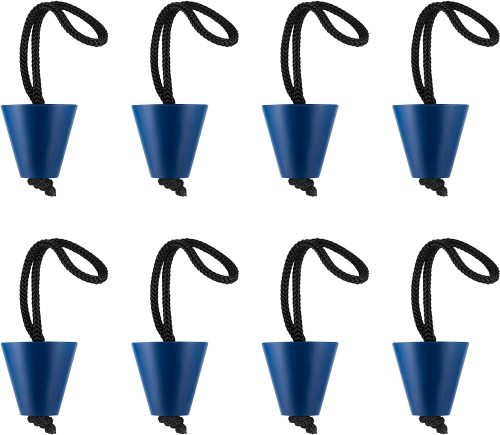
This 8-piece scupper plug kit features plugs made of sturdy, waterproof silicone, which will be more resistant to wear and tear and water damage than rubber and inexpensive plastic. The plugs also come with an integrated lanyard loop that makes it easy to pull the plug when you want the water to drain out.
At their narrowest, they’re 0.7 inches across, and up to 1.5 inches across at their widest point. This makes them suitable to use in pretty much any scupper plug on a sit-on-top kayak.
Universal Kayak Scupper Plugs
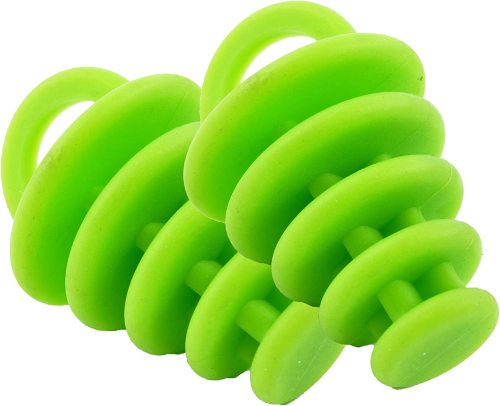
These scupper plugs are built “smarter” in a couple of great ways. First off, they’re colored a bright lime green, which means they’re far less likely to get lost if they fall out in your garage, storage shed, or truck bed. They even glow in the dark so you can easily find them on the deck of your kayak if you’re paddling in the dark.
The five-tiered design means that they’ll fit into any scupper hole, and can be easily inserted and removed. You’ll have to secure your own cord/rope to the scupper plugs, but they feature a handy loop at the end that makes it easy to do so. The only real downside is that they come only in pairs, but cost as much as the 8-pack above.
Pelican Sit-on-Top Kayak Scupper Plugs 4 Pack
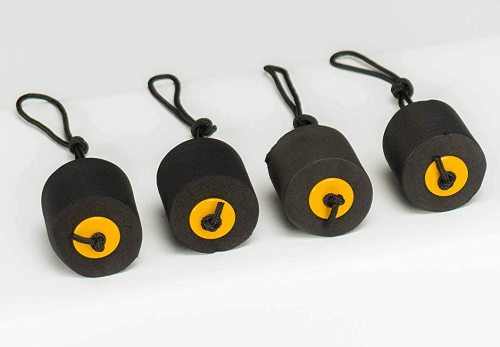
If you happen to have a Pelican sit-on-top kayak, this may be the scupper plugs pack for you. It’s designed specifically for all the Pelican kayaks, using compressive EVA foam that will insert securely into the scupper holes on your Pelican kayak.
It comes in two sizes (small and medium) fitting holes as large as 1.75 inches in diameter. Thanks to the integrated cord loop, you’ll find they’re beautifully easy to pull and re-insert.
CANALHOUT 8 Pieces Kayak Scupper Plugs Kit
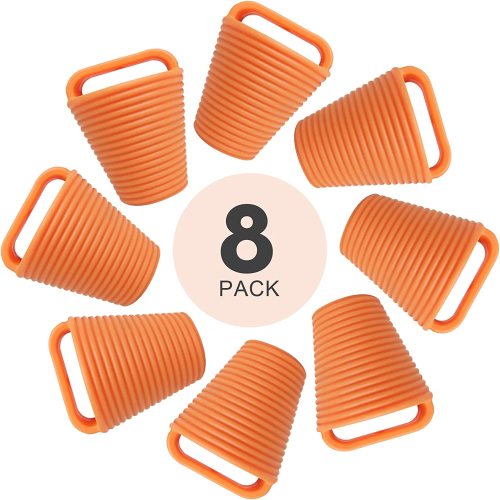
These plugs are made using TPE, a softer version of the same thermoplastic that’s used in the construction of most hard-shell plastic kayaks. The multi-layered construction offers a secure fit, and the pull ring makes it easy to pull the plug by hand but can also double as a place to secure the lanyard or pull cord.
This 8-pack offers the best value around, though the plugs won’t last quite as long as silicone or sturdy rubber. Still, it comes in a wide range of colors that makes it easy to match or contrast with the color of your kayak.
Conclusion
Scupper plugs are absolutely essential to the proper functioning of your kayak, providing both easy drainage and easy waterproofing to keep your kayak floating properly. It’s definitely worth making sure your existing plugs are in good shape, as well as replacing them when and as needed!

